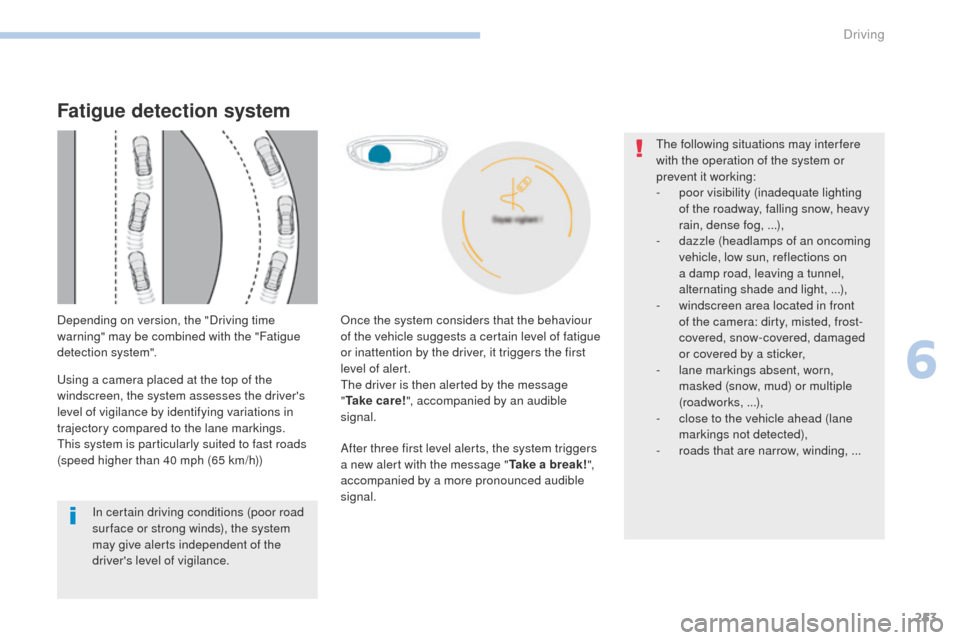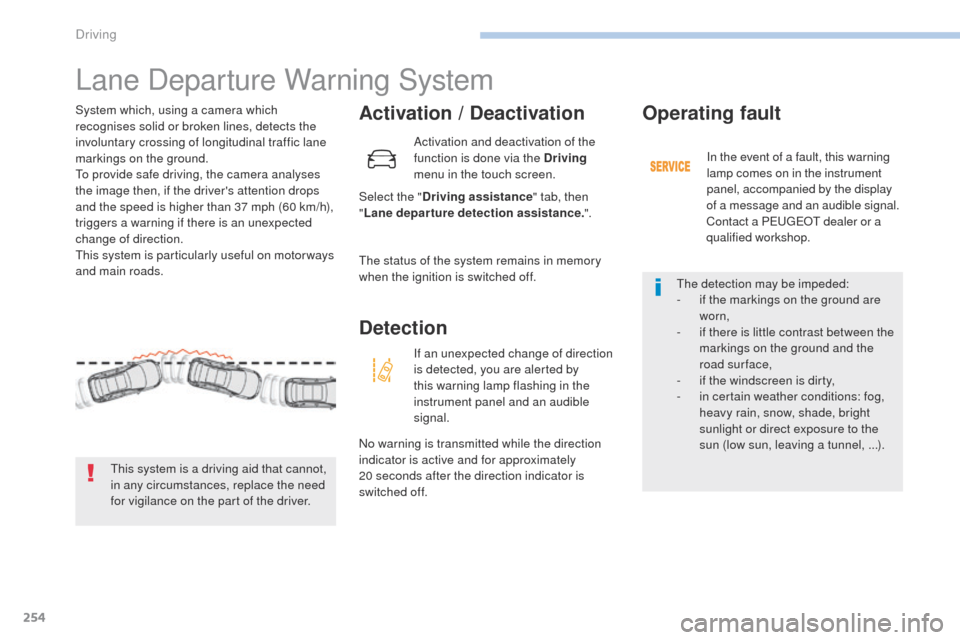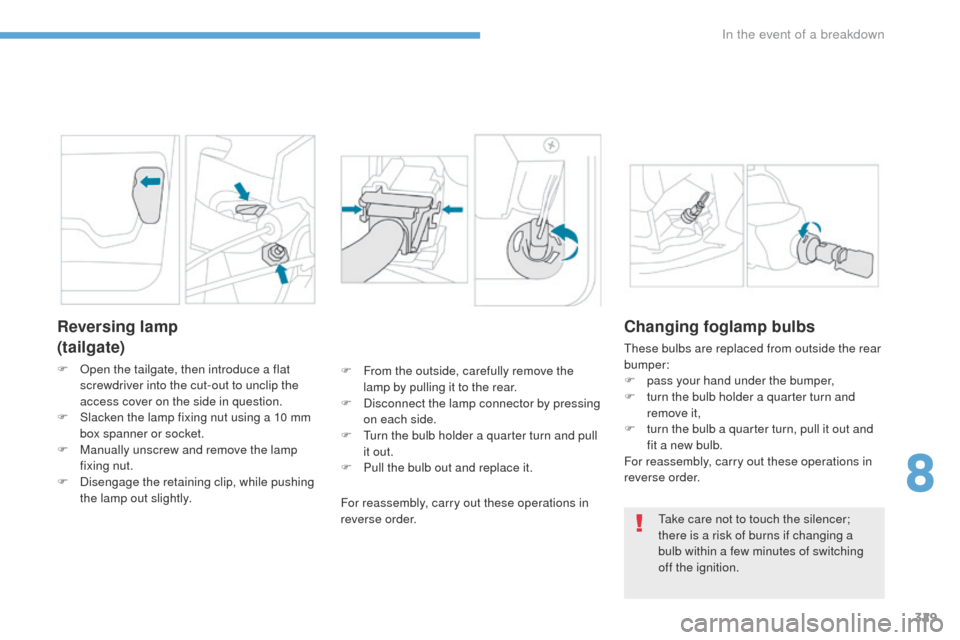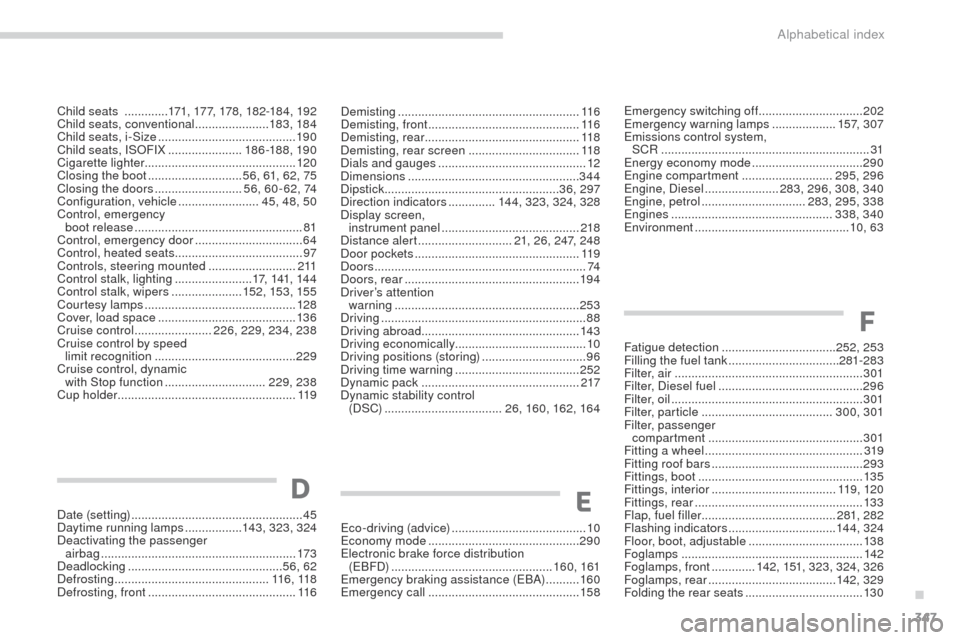2017 Peugeot 3008 Hybrid 4 fog light
[x] Cancel search: fog lightPage 253 of 566

251
3008-2_en_Chap06_conduite_ed01-2016
Deactivation / ActivationOperating fault
In the event of a fault, you are alerted
by the illumination of this warning
lamp, accompanied by the display of
a message and an audible signal.
Clean the windscreen regularly,
particularly the area in front of the
camera.
Do not allow snow to accumulate on
the bonnet or roof of the vehicle as this
could mask the camera's view.
Clean the front bumper, removing mud,
snow, ...
If the front bumper is to be repainted,
contact a PEUGEOT dealer or a
qualified workshop. Certain types of
paint could inter fere with the operation
of the radar.
Check that the sensors (camera and radar) are
not covered by dirt, mud, frost, snow...
If the problem persists, contact a PEUGEOT
dealer or a qualified workshop to have the
system checked.
By default, the system is automatically
activated at every engine start.
The system can be deactivated or activated in
the vehicle settings menu in the screen.
Deactivation of the system is
signalled by the illumination of this
indicator lamp, accompanied by the
display of a message. There may be interference in the
operation of the camera or it may not
work at all in the following situations:
-
p
oor visibility (inadequate street
lighting, falling snow, heavy rain,
dense fog, ...),
-
d
azzle (headlamps of an
approaching vehicle on the other
side of the road, low sun, reflection
on a wet road, leaving a tunnel,
alternating between light and
shade, ...),
-
c
amera or radar masked (mud,
frost, snow, ...).
In these situations, detection
performance may be reduced.
6
Driving
Page 255 of 566

253
3008-2_en_Chap06_conduite_ed01-2016
After three first level alerts, the system triggers
a new alert with the message "Take a break!",
accompanied by a more pronounced audible
signal.
In certain driving conditions (poor road
sur face or strong winds), the system
may give alerts independent of the
driver's level of vigilance. The following situations may inter fere
with the operation of the system or
prevent it working:
-
p
oor visibility (inadequate lighting
of the roadway, falling snow, heavy
rain, dense fog, ...),
-
d
azzle (headlamps of an oncoming
vehicle, low sun, reflections on
a damp road, leaving a tunnel,
alternating shade and light, ...),
-
w
indscreen area located in front
of the camera: dirty, misted, frost-
covered, snow-covered, damaged
or covered by a sticker,
-
l
ane markings absent, worn,
masked (snow, mud) or multiple
(roadworks, ...),
-
c
lose to the vehicle ahead (lane
markings not detected),
- r oads that are narrow, winding, ...
Once the system considers that the behaviour
of the vehicle suggests a certain level of fatigue
or inattention by the driver, it triggers the first
level of alert.
The driver is then alerted by the message
"
Ta k e c a r e ! ", accompanied by an audible
signal.
Fatigue detection system
Depending on version, the "Driving time
warning" may be combined with the "Fatigue
detection system".
Using a camera placed at the top of the
windscreen, the system assesses the driver's
level of vigilance by identifying variations in
trajectory compared to the lane markings.
This system is particularly suited to fast roads
(speed higher than 40 mph (65 km/h))
6
Driving
Page 256 of 566

254
3008-2_en_Chap06_conduite_ed01-2016
Lane Departure Warning System
Activation / Deactivation
Select the "Driving assistance " tab, then
" Lane departure detection assistance. ".
System which, using a camera which
recognises solid or broken lines, detects the
involuntary crossing of longitudinal traffic lane
markings on the ground.
To provide safe driving, the camera analyses
the image then, if the driver's attention drops
and the speed is higher than 37 mph (60 km/h),
triggers a warning if there is an unexpected
change of direction.
This system is particularly useful on motor ways
and main roads.
This system is a driving aid that cannot,
in any circumstances, replace the need
for vigilance on the part of the driver. Activation and deactivation of the
function is done via the Driving
menu in the touch screen.
The status of the system remains in memory
when the ignition is switched off.
Detection
If an unexpected change of direction
is detected, you are alerted by
this warning lamp flashing in the
instrument panel and an audible
signal.
No warning is transmitted while the direction
indicator is active and for approximately
20
seconds after the direction indicator is
switched off.
Operating fault
In the event of a fault, this warning
lamp comes on in the instrument
panel, accompanied by the display
of a message and an audible signal.
Contact a PEUGEOT dealer or a
qualified workshop.
The detection may be impeded:
-
i
f the markings on the ground are
worn,
-
i
f there is little contrast between the
markings on the ground and the
road surface,
-
i
f the windscreen is dirty,
-
i
n certain weather conditions: fog,
heavy rain, snow, shade, bright
sunlight or direct exposure to the
sun (low sun, leaving a tunnel, ...).
Driving
Page 260 of 566

258
3008-2_en_Chap06_conduite_ed01-2016
Limits of operation
The system goes into standby automatically in
the following cases:
-
E
SC deactivated or operation triggered,
-
s
peed below 40 mph (65 km/h) or above
112 mph (180 km/h),
-
c
onnected electrically to a trailer,
-
u
se of the "space-saver" spare
wheel detected (as detection is not
immediate, deactivation of the system is
recommended),
-
d
ynamic driving style detected, pressure
on the brake or accelerator pedal,
-
d
riving where there are no lane markings,
-
ope
ration of the direction indicators,
-
d
riving in a tight corner,
-
i
nactivity by the driver detected during
correction. The system may not operate correctly
or at all in the following situations:
-
c
onditions of poor visibility
(inadequate street lighting,
snowfall, rain, fog),
-
d
azzle (headlamps of on oncoming
vehicle, low sun, reflections on a
wet road sur face, leaving a tunnel,
alternating light and shade),
-
a
rea of the windscreen in front of
the camera dirty, misted, frosted,
snow-covered, damaged or
covered by a sticker,
-
r
oad markings absent, worn,
hidden (snow, mud) or multiple
(roadworks),
-
r
unning close to the vehicle in front
(the lane markings may not be
detected),
-
n
arrow, twisty roads.Risk of undesirable operation
Deactivation of the system is recommended in
the following situations:
-
d
riving on a road sur face in poor condition,
-
u
nfavorable weather conditions,
-
d
riving on slippery sur faces (black ice).
The system is not designed for the following
driving situations:
-
d
riving on a speed circuit,
-
d
riving with a trailer,
-
d
riving on a rolling road,
-
d
riving on unstable sur faces.
Driving
Page 331 of 566

329
3008-2_en_Chap08_en cas-de-panne_ed01-2016
Reversing lamp
(tailgate)
F Open the tailgate, then introduce a flat screwdriver into the cut-out to unclip the
access cover on the side in question.
F
S
lacken the lamp fixing nut using a 10 mm
box spanner or socket.
F
M
anually unscrew and remove the lamp
fixing nut.
F
D
isengage the retaining clip, while pushing
the lamp out slightly. F
F rom the outside, carefully remove the
lamp by pulling it to the rear.
F
D
isconnect the lamp connector by pressing
on each side.
F
T
urn the bulb holder a quarter turn and pull
it out.
F
P
ull the bulb out and replace it.
For reassembly, carry out these operations in
reverse order.
Changing foglamp bulbs
These bulbs are replaced from outside the rear
bumper:
F
p
ass your hand under the bumper,
F
t
urn the bulb holder a quarter turn and
remove it,
F
t
urn the bulb a quarter turn, pull it out and
fit a new bulb.
For reassembly, carry out these operations in
reverse order.
Take care not to touch the silencer;
there is a risk of burns if changing a
bulb within a few minutes of switching
off the ignition.
8
In the event of a breakdown
Page 349 of 566

347
3008-2_en_Chap11_index-alpha_ed01-2016
Demisting ......................................................11 6
Demisting, front ............................................. 11 6
Demisting, rear
.............................................. 11
8
Demisting, rear screen
.................................118
Dials and gauges
............................................ 12
Dimensions
................................................... 344
Dipstick
................
.................................... 36, 297
Direction indicators
..............14 4, 323 , 324, 328
Display screen, instrument panel
...............................
..........218
Distance alert
............................ 21, 26 , 247 , 248
Door pockets
................................................. 11
9
Doors
............................................................... 74
Doors, rear
.................................................... 19 4
Driver’s attention warning
...............................
........................253
Driving
............................................................. 88
Driving abroad ............................................... 143
Driving economically ....................................... 10
Driving positions (storing)
...............................96
Driving time warning
..................................... 252
Dynamic pack
..............................
.................217
Dynamic stability control (DSC)
................................... 26, 160 , 162, 16 4 Emergency switching off ...............................
2 02
Emergency warning lamps ................... 15
7, 307
Emissions control system, SCR
..............................................................31
Energy economy mode
.................................290
Engine compartment
...........................295, 296
Engine, Diesel
...................... 28
3, 296 , 308 , 340
Engine, petrol
...............................283, 295 , 338
Engines
................................................338, 340
Environment
...............................
...............10, 63
Child seats
.............
17
1
, 17 7 , 178 , 182-18 4 , 192
Child seats, conventional
...................... 183, 18 4
Child seats, i-Size
...............................
.......... 19 0
Child seats, ISOFIX
...................... 18
6 -188 , 19 0
Cigarette lighter ............................................. 120
Closing the boot
............................ 56, 61 , 62 , 75
Closing the doors
.......................... 56, 60-62 , 74
Configuration, vehicle
........................ 45, 48 , 50
Control, emergency boot release
.................................................. 81
Control, emergency door
................................ 64
Control, heated seats
...................................... 97
Controls, steering mounted
.......................... 2 11
Control stalk, lighting
....................... 17,
141 , 14 4
Control stalk, wipers
..................... 152, 153 , 155
Courtesy lamps
............................................. 128
Cover, load space
......................................... 13
6
Cruise control
....................... 2
26 , 229 , 234 , 238
Cruise control by speed limit recognition
.......................................... 229
Cruise control, dynamic with Stop function
.............................. 229, 238
Cup holder
...............................
...................... 11 9
F
Fatigue detection .................................. 252, 253
Filling the fuel tank ................................. 28
1-283
Filter, air
...............
......................................... 301
Filter, Diesel fuel
........................................... 296
Filter, oil
......................................................... 301
Filter, particle
....................................... 300, 301
Filter, passenger compartment
.............................................. 3
01
Fitting a wheel
...............................
................319
Fitting roof bars
............................................. 293
Fittings, boot
................................................. 13
5
Fittings, interior
..................................... 11 9, 120
Fittings, rear
...............................
...................13 3
Flap, fuel filler
...............................
.........281, 282
Flashing indicators
................................ 14 4, 324
Floor, boot, adjustable
..................................13 8
Foglamps
...................................................... 142
Foglamps, front
.............142, 151 , 323 , 324, 326
Foglamps, rear
...................................... 142, 329
Folding the rear seats
...................................13 0
D
Date (setting) ............................... ....................45
Daytime running lamps .................143, 323 , 324
Deactivating the passenger airbag
.......................................................... 17
3
Deadlocking
.............................................. 56, 62
Defrosting
.............................................. 11 6, 118
Defrosting, front
............................................ 11
6E
Eco-driving (advice) ........................................ 10
Economy mode ............................................. 290
Electronic brake force distribution (EBFD)
................................................ 160, 161
Emergency braking assistance (EBA)
.......... 16
0
Emergency call
............................................. 15
8
.
Alphabetical index
Page 558 of 566

18
Deactivation / Activation
By default, the system is automatically
activated at every engine start-up.
The system can be deactivated or activated via
the vehicle settings menu.Deactivation of the system is
signalled by the illumination of this
indicator lamp, accompanied by the
display of a message. Clean the windscreen regularly,
particularly the area in front of the camera.
Do not allow snow to accumulate on the
bonnet or roof of the vehicle as this could
conceal the detection camera.
Clean the front bumper, removing mud,
snow, etc.
If the front bumper is to be repainted or
retouched, contact a PEUGEOT dealer
or a qualified workshop. Certain types of
paint could inter fere with the operation of
the radar.
Operating fault
Check that the sensors (camera and radar) are
not covered by dirt, mud, frost, snow, etc.
If the fault persists, contact a PEUGEOT dealer
or a qualified workshop to have the system
checked.In the event of a fault with the system,
you are alerted by the tell-tale lighting
up, accompanied by the display of a
message and an audible signal.
The camera my be disrupted or not work
in the following situations:
- poor visibility (inadequate street
lighting, falling snow, heavy rain,
dense fog, etc.),
- dazzle (headlamps of an oncoming
vehicle, low sun, reflections on
a damp road, leaving a tunnel,
alternating shade and light, etc.),
- obstruction of the camera or radar
(mud, frost, snow, etc.).
In these situations, detection performance
may be reduced.
Driving